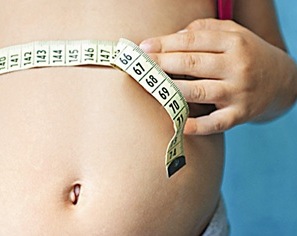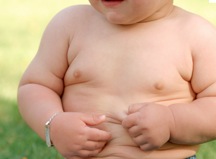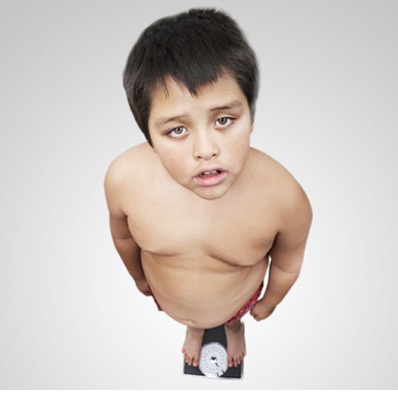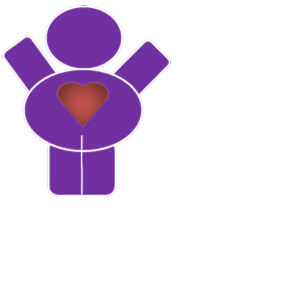Obesity in Children
Obesity constitutes a public health problem and is one of the epidemic ailments of developed countries. In recent years, due to imitation and consumption of high-energy foods, its frequency has increased in Mexico.

Often, obesity is thought of as transitory and as an expression of growth and development in an individual. Unfortunately, this opinion is not only shared among the majority of people but also among some doctors who don’t give it its due importance when they detect it. In 50 percent of cases it appears before the age of two. In the rest it appears in the periods of major growth, particularly during puberty and adolescence.
In institutional medical practice, as with private practice, you meet more obese children and adolescents each day that generally come from the middle and upper classes.
Obesity is associated with 300 thousand deaths a year. Approximately 80 percent of obese adolescents will continue to be obese the rest of their lives. Less than five percent of adults who lose weight are able to maintain their ideal weight five years after treatment and six percent regain their lost weight during the first six to twelve months after losing it. Obesity, among other causes, contributes to an increase in mortality due to cardiovascular disease, diabetes mellitus, skeletal alterations, arterial hypertension, hypercholesterolemia and, among the most important, psychosocial maladaptation.
What is understood by obesity?
The word obesity is derived from the Latin word obesus, which means “Person who has excess fat.” It is characterized by the accumulation and storage of excessive fat, mainly in the adipose tissue. It manifests itself by a weight gain of more than 20 percent over the ideal weight, considering the person’s age, size and sex. In children, a practical way, although not exact, to calculate the weight of those between two and five years of age is to multiply their age by two and add eight (three year old: 3 x 2 + 8 = 14 Kg). These factors must be carefully compared when analyzing obesity in children and adolescents.
In most cases, the doctor, parents and the child are more worried about the social problems that obesity causes rather than the metabolic alterations and complications that may occur.
What may cause my child to be obese?
Obesity during infancy and adolescence is a result of a complex interaction among genetic, psychological, environmental and socioeconomic factors. Factors such as the health status and the environment in which the child grows up play a major role in the genesis of obesity.
Predisposed factors for a child to become obese are: overweight parents and inadequate family feeding habits, which are more frequent when the mother is the obese parent by virtue that she spends the most time with the child. Sedentary attitudes such as eating snacks while watching TV, riding in the car and playing video or board games favor obesity.
How does obesity manifest itself?
The belief that parents and some doctors hold that a nursing obese child is synonymous with health is false. At first, when the weight gain is progressively slow, the parents are happy because their child seems healthy, then chubby and ultimately fat after the child’s weight exceeds 20 percent of his ideal weight.

Yes. The ability of the child to differentiate between hunger and other necessities or attachments is developed by the reciprocal experiences shared at his mother’s side. Whenever the mother feeds the child in response to non-nutritional requests such as tenderness, anger or fear, he will not be able to differentiate between hunger and being upset. This will cause overfeeding and confusion in the emotional needs of the child, which will in turn make the child unclear about his basic necessities and promote greater insecurity.
Regarding their appearance and acceptance, obese children and adolescents exhibit little tolerance toward the bad attitudes of their peers and relatives, which can quickly make them feel ostracized and rejected and whose insults can be very damaging.
This condition is worsened in adolescents that happen to be going through physical changes appropriate for their age. Being obese or slightly overweight is not hip.
How can obesity arise in my child?
Even if their children are not obese, parents should closely monitor their nutrition and limit excessive food intake. Teaching children what, how and when to take foods is the best way to nutritionally educate them. Since eating together is a social and bonding experience within the family, the opportunity to prevent infantile obesity should be taken at that time to avoid getting to the point where treatment is needed, which is very complex and lengthy. Properly feeding children from the start and during their first few years of life is the best way to prevent obesity from arising. It’s during the first few months of a child’s life that he learns to identify foods and its flavors and textures, acquires eating habits, and develops tastes and preferences for foods.
Through breast feeding, the child freely consumes what he or she needs, while with bottle feeding, the child tends to be overfed, which can be the beginning of bad eating habits and obesity.

During the first two years of life, a child’s eating habit is formed through learning how, when, where and with whom the child eats. Rules for eating, such as setting a specific schedule for meal times, determining the place where you will have your meals, pointing out the appropriate behavior at the dinner table, promoting appropriate mastication and noting the available time for eating, among others, should be the foundation for eating habits.
Using certain foods and especially snacks as rewards is not advisable, since this is outside of the rules for good nutrition and could cause the child to start having a marked preference for these foods by relating them to behavior that was positive in their parents’ eyes.
We will now point out the importance of the parents’ active role in the total management and treatment of the obese child.
How can I participate in the treatment of my child’s obesity?
The treatment for the obese patient is multidisciplinary. You should consult your doctor at the first suspicion of overweightness. Your doctor will need the support of a pediatric endocrinologist, nutritionist, pediatric psychiatrist, pediatric gastroenterologist and psychologist for an integral management of the treatment.
Parents should observe the child to see if he shows any changes in his growth and development, not cause any metabolic alterations, diminish his appetite, and try to avoid psychological problems, all of which are objectives to strive for during treatment.
Changing the eating habits of the child and family.
Educating your child and modifying your family’s eating habits is not an easy task. However, there are different techniques that will make it easier, which we recommend below:
Daily control. Consists of the child having a weekly journal of the foods consumed, specifying the quantities, as well as what type of physical activity he or she performs and for how long. Avoid activities that influence eating outside of the scheduled times, such as going grocery shopping before eating and snacking. Eating foods that are customarily accompanied by other high caloric foods such as hamburgers with fries and soda, pizzas, hot dogs, especially what is known as “fast food.” Commit the child to pay special attention to his or her diet and physical activity; it will make the child more conscientious and responsible regarding his or her health issues.

Adopting a Proper Diet for the Stage of Growth.
The daily caloric requirements will be provided under medical prescription in accordance with the stage of growth and development of the child. It’s advisable to suggest to the doctor the foods that the child customarily eats and particularly those that he prefers. That way the doctor can select from those the most appropriate foods for the new diet.
As much as possible and in accordance with the child’s age, individualize the diet, divide it among the daily meals and preferably with an exchange program to choose foods. Remember that the dietary prescription is only one part of the nutritional treatment.
Very low caloric diets are not intended for children or adolescents. These diets are generally used for short periods of time and do not modify the nutritional habits, which also isn’t recommended for children. Let’s not forget that the child pertains to a social environment in which nutrition plays a vital role.
Children learn bad eating habits from their parents. Adding salt before tasting the food, as well as using sugar, condiments, sauces and oils in excess are just a few examples of what children acquire during the day’s meals, at first by imitation, which they then subsequently repeat creating bad eating habits for the rest of his life.
Practicing Exercise and Routine Physical Activities.
This favors energy consumption and contributes to weight loss. Incorporating daily physical activity into the lives of children and adolescents is of utmost importance. It is recommended that the physical activity be performed with parents, siblings or friends 3 to 5 days a week, beginning with 15 minutes and increasing up to an hour. Activities such as walking, swimming, cycling, as well as any sport that is fun and of interest to the child, such as playing soccer or skating. On the other hand, you should favor physical activity at home, try to walk more, use the stairs instead of an elevator and go bike riding. Reduce sedentary activities, which take up a lot of time, such as watching television, using the computer and playing video games.
The benefits of physical activity in the treatment of obesity has two fundamental pillars: the caloric expenditure of exercise, strictly speaking, and the psychological factor, which includes a decrease in appetite through anxiety control and the improvement of one’s own body image. These are the main benefits:
- Decrease in blood pressure
- Increase in pulmonary capacity
- Increase in muscle strength
- Increase in aerobic capacity
- Reduction of fatty tissue
- Decrease in triglyceride levels
- Increased HDL levels
- Decrease of insulin levels
- Improvement in one’s own body image
- Change in eating behavior, with a reduction in appetite, especially in anxiety

The physical activity should be preferably aerobic (walking, jogging, gymnastics, bicycling, swimming), which is recommended 3 times a week for 30 to 40 minutes a session. It is important to gradually increase the exercise and to know your limits. Every individual has personal considerations in the selection of what type of activity to choose. In order to avoid complications, a professional should evaluate the person. Generally bicycling and walking are well tolerated in all cases.
Physical activity is a fundamental pillar for the treatment of weight disorders, modifying the body’s composition and metabolism, improving the relationship between food and the body. Therefore, this improvement makes long-term treatment possible, which culminates with a change in the individual’s bad habits.
Active Parent Participation
This is the most important action out of the whole treatment. The type, amount and preparation of foods that the child will eat greatly depend on the parents. It’s very useful to modify the eating habits of the whole family. Don’t buy foods that the child can’t eat, use small plates, offer smaller food portions, keep foods out of the child’s sight and educate through example. On occasion, the parents indirectly provoke the child’s obesity by offering foods to the child in order to distract them. They offer them sweets when they are “busy” and can’t tend to their needs or reward them with cakes, candies, chocolates and ice cream.


